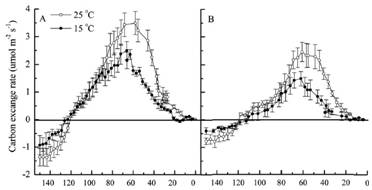Carbon Exchange Responses of Cyanobacterial-Algal Crusts to Dehydration, Air Temperature, and CO2 Concentration
2012-03-13
Biological soil crusts contain cyanobacteria, algae, microfungi, lichen, and bryophytes as their biological components, these biota are intimately associated with soil particles in different proportions. They occupy the bare land between vascular plants, and their coverage approximately constitutes 70% of all living organisms in the area. They use much smaller amounts of moisture to initiate their physiological activities, including photosynthesis and respiration. Therefore, biological soil crusts in dry areas can have profound influence on the carbon balance between the atmosphere and the soil. However, studies on the carbon exchange of crusts with different histories of crust development are rare, especially in terms of the responses of carbon exchange to increasing atmospheric CO2 concentrations and decreasing water contents of crust organisms.
The Tengger Desert is located in Northern China and is the fourth biggest desert in China. Cyanobacterial-algal crusts show very good formation and development in this area. Two cyanobacterial-algal crusts with different development histories of (26 and 51 years exist in the site) significantly differ in their species composition. Therefore, this area presents a valuable opportunity to study the carbon exchange of biological soil crusts with different species compositions under the background of global change.
Therefore, two laboratory experiments were conducted to elucidate the carbon exchange of the cyanobacterial-algal crusts. Researchers classified sites in Shapotou in the Tengger Desert as recent (site revegetated in 1981 in mobile sand dunes) and old (site revegetated in 1956) successional stages, and systematically analyzed the changes in the carbon exchange of cyanobacterial-algal crusts developed in the two sites to dehydration, air temperature (15 and 25°C), and CO2 concentration (200-2000 ppm).
The old crusts had a higher carbon exchange rate than the recent crusts during dehydration, and the maximum carbon exchange rates were 3.49 and 2.45 μmol/m2·s for the old and recent crusts, respectively, at an approximately 60% water content of dry crust organisms. The carbon exchange rate was higher at 25°C than at 15°C for both crusts. No difference in the CO2 saturation points between the two crusts and between the two temperatures was observed, however, the saturation point significantly increased with the increase in the water content of the crust organisms, from 224 to 1384 ppm, when the water content of the crust organisms was increased from 20% to 100%. The water content of the crust organisms was the regulating factor for the carbon exchange rate of both the old and recent cyanobacterial-algal crusts.
The result has been published on Arid Land Research and Management, 2012, 26: 44-58. The paper is also archived at http://www.tandfonline.com/doi/abs/10.1080/15324982.2011.631689.

The response of carbon exchange rate (mean ±S.E.) during the process of dehydration at two temperatures of 25°C and 15°C for old crusts (A) and recent crusts (B). Measurements were made at 360 ppm under a photosynthetic photon flux density (PPFD) of 1000 μmol/m2·s.



